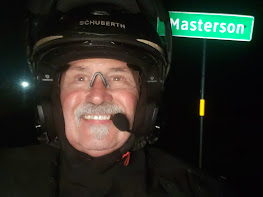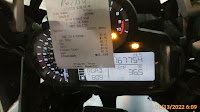The challenge of the Iron Butt Association's iconic Ride Around Texas - RAT has been doubled!
After the highest turnout for the 2021 Ride Around Texas, RAT, at the Big As Texas "Ride-a-Palooza" last October, I got the idea to create the RAT version of the 100ccc. Two consecutive RATs, one in each direction, Clockwise then "Rewind" Anti-Clockwise.
I proposed the idea to Dr. Howard Entman, Director of Operations at the IBA Institute for Ride Development (LOL) and Mike Kneebone, President of the IBA. Howard said, "Why not?!" It was then on me to validate the certification protocols. My hope is the Ride Around Texas Rewind becomes the template for all other "Ride Around" in the list of In-State portfolio of rides. Example; Ride Around Alabama Rewind, Ride Around Arkansas Rewind, etc.
Below are the current rules for the RAT Rewind on the IBA Ride Around Texas page. Based on my validation of the ride, I am making this recommendations. Require the Start - Rewind - Finish be at the same DBR location. This will ensure complete rotations each direction. For example, I could have easily gotten a start DBR at a location next to the Galveston-Port Bolivar Ferry, and a finish DBR at the end of I-45, cutting the full rotation around Texas by several miles. Making the Start/Rewind/Finish DBR from the same business is in keeping with the spirit of a complete Ride Around Texas.
 |
| Graphic work by Donna Fousek |
RAT Rewind Objective: Ride 2 consecutive rotations around the perimeter of Texas, one clockwise and one anti-clockwise, stopping at 18 mandatory checkpoints, including start/finish point, in order within the allotted time period for each rotation. This is a back-to-back ride and follows typical back-to-back rules.
RAT Rewind - less than 85 hours each rotation (170 hour total)
RAT Rewind Gold - less than 70 hours each rotation (140 hour total)
Note: The Ending DBR date/time of the first rotation is the Start date/time of the second opposite rotation. For RAT Rewind each rotation must be less than 85 or 70 hours. You can not carry over unused hours from one rotation to the opposite rotation. For RAT Rewind GOLD each rotation must be under 70 hours.
I have split the entire ride into each of the rotations to make it easier to compare the Plan vs Actual RidePace.
RidePace
I rode just shy of 6,200 miles during the RAT Rewind GOLD in 5 days and 12 hours (132:00 / 24 hours = 5.5).
I did not use excessive speed during the RAT Rewind. With many of the Texas highways 75 MPH there was no need to use excessive speeds to make up for delays. As one would expect, most of the delays were due to construction work. Especially, between Kermit and Guadalupe NP along FM652. The "Oil Patch" in the Permian Basin is like a wild west mining town...extending everywhere. There were at least a half dozen single lane closures with. I lost at least 1 hour total with each rotation.
I did not have any mechanical or farkle issues. My 2016 BMW R1200GS Adventure ran great. I did experience comfort stress issues with my eyewear rubbing my ears, as well as chafing around my neck and wrists. Probably from not doing an hard riding adventures in a while. This was my first extended IBA certification ride since my crash on the Janus, May 2020.
Weather was not an issue. Clear skies but chilly temperatures in the panhandle.
I really felt great during this ride! My ride pace was significantly enhances by my feeding regimen. For the past three years I eat only one meal a day. By practicing intermittent fasting, I have trained my body to be metabolically flexible. That is, my body looks for energy from body fat stores when available glycogen, stored in my liver and muscles, get used up. As a result, I never experience "hunger" or lack of energy. I have noticed my attention level to the riding task is much sharper during the fasted state. I suspect this is due to the elevated ketone bodies, produced by my liver, to fuel my brain. The result is less food driven behaviors and more focus on the riding tasks. Check out this video for more information about mental clarity attributed to not eating so often: "
What Intermittent Fasting Does to Your Brain"
RidePace Metrics:
- Start - Finish: 5:56 Nov 8 - 17:56 Nov 13
- Total Time: 132:00 (AC 64:27 + CW 67:33) 132:19 Planned
- MC Miles: 6,170
- GPS Miles: 6,187.6 6,190 Planned
- Moving Time: 90:29 97:24 Planned
- Stopped Time: 42:29
- Overall Avg MPH: 46.9 MPH (GPS Miles / Total Time)
- Moving Avg MPH: 68.4 MPH (GPS Miles / Moving Time)
Risks
I started this ride the weekend DST ended. There was a lot of night riding. Especially, in remote areas. The GSA has great OEM lights. I also use Denali D4 aux lights. The combination of the two lighting systems illuminated the path of travel very well. But, using the PathFindIR FLIR camera feeding a display in my forward view provide long-distance alerts to any animals on the road or shoulders. I saw lots of critters on the side of the road. Especially, in Big Bend. I had to scrub off speed when a Javilina was walking across my path of travel.
River Road, FM170, was actually easier to ride at night than in the daytime. I have ridden FM170 many times during the day. Texas DOT has done a great job of marking the entire length with reflective markers. I rode FM170 twice during this ride, both at night. It was easier and less risky than I thought.
Navigation
I planned an Anti-Clockwise start. Using Garmin BaseCamp I plotted each rotation. This produced a route plan which allowed me to plug in dwell times at each of the mandatory stops. As well as giving me the opportunity to insert planned rest stop time along the way. BaseCamp then added up all the riding, pit stop and rest time to calculated estimated finish time.
Plotting the 6 hours of "Rest" along each segment gave me the flexibility to choose the time and location for a hotel stop. As an example, I planned 6 hours rest in Anthony during the CW rotation. It was late when I got to Presidio after scoring Panther Junction and Lajitas General Store. So, instead of riding to Anthony, arriving about 2am, I stopped in Van Horne for the hotel rest stop. I left Van Horn after 5 hours of rest to meet my planned departure time in Anthony of around 8:05 MST. This made the second segment of the CW rotation work out great. I actually arrive in Childress for my next scheduled rest stop a half hour early.
I used a Garmin zumoXT as the primary navigation tool and Android Auto with Google Maps as backup. The zumoXT was excellent. This was the first time I used the zumoXT for a long-distance timed event. It worked well.
RIDECRAFT: The collection of knowledge, skills and abilities used by a long-distance motorcycle rider to maintain a consistent ride pace, manage risk and achieve navigational objectives.
(c) 2012. T.Masterson





















